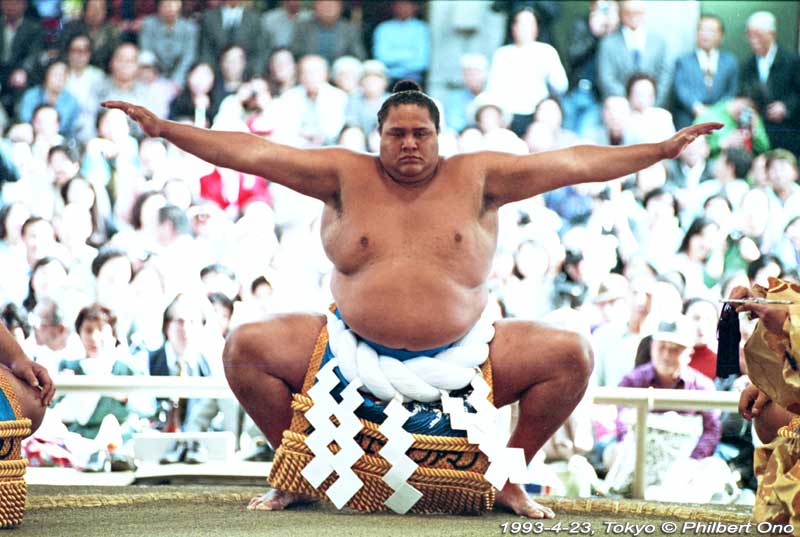
Akebono Tribute Contents
- Azumazeki Stable
- Ozeki Promotion
- Yokozuna Promotion (Current page)
- Retirement Ceremony
Akebono is promoted to yokozuna in January 1993 in record time of five years. *This article first published in 1993, updated in May 2023.
Many people (mostly foreigners) have long waited for one. Some people (mostly Japanese traditionalists) have dreaded one. Others (mostly sumo stablemasters) have only dreamed of one: a gaijin yokozuna.
The wait has finally ended and the time has come. Akebono (“dawn” in Japanese 曙), alias Chad Rowan from Hawaii, is now king of the hill, top of the heap, and yokozuna (横綱). He has secured a place in Japanese history as sumo’s first non-Japanese grand champion.
After Akebono’s ozeki promotion in May 1992, the key question was, “Will he make it to yokozuna?” While we pondered over this, he had a heart-breaking toe injury forcing him to delay his ozeki debut by skipping the July 1992 tournament in Nagoya.
Fortunately in the following tournament in September 1992, he preserved his rank with a 9-6 record. He later made up for his disappointing start as ozeki by winning the November 1992 and January 1993 tourneys. He was consequently elevated to yokozuna, after only 30 sumo tournaments (five years, one of the fastest on record) and only four tournaments (eight months) as an ozeki. An incredible feat when you consider that it took the great Kitanoumi 46 tourneys and Chiyonofuji 66 tourneys to make yokozuna. Few people had expected Akebono to become yokozuna so soon.
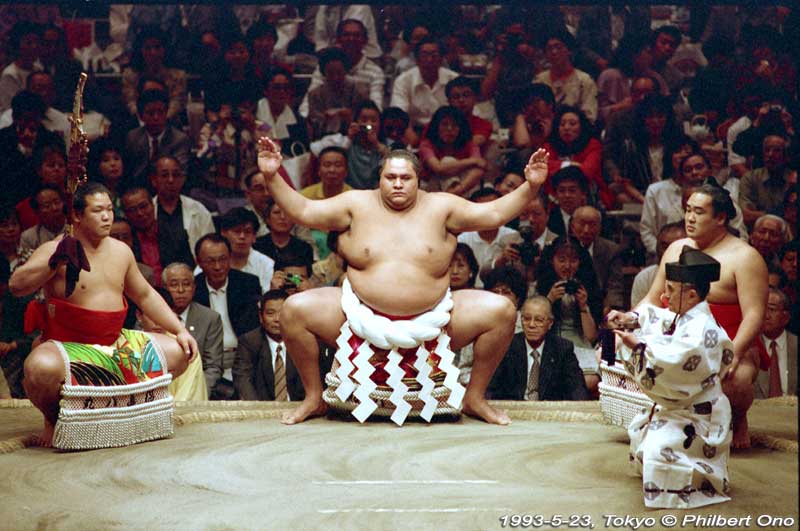
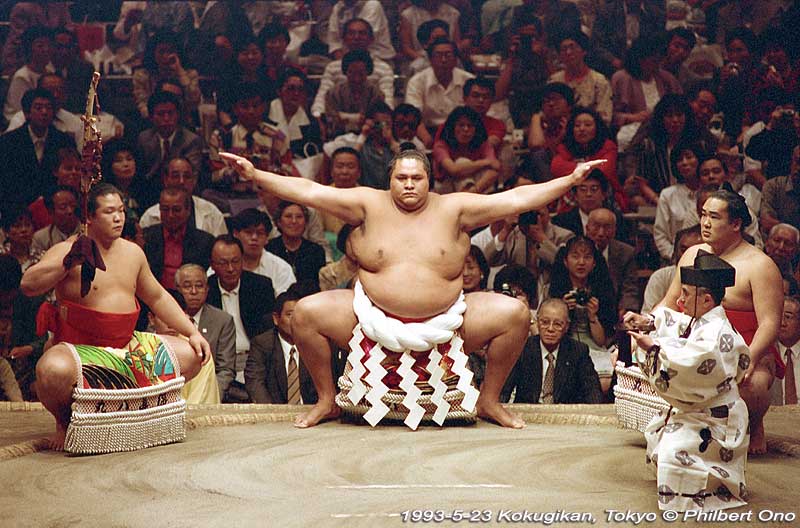
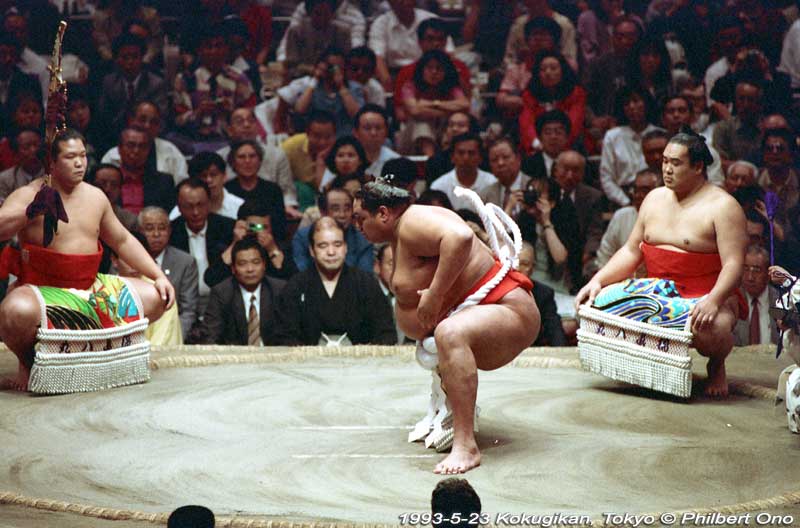
With so many foreigners treading the sumo path, a gaijin yokozuna was a matter of course. Since 1964 when Jesse Kuhaulua (Takamiyama) came to Japan, over 85 foreigners have entered professional sumo. Currently, there are about 30 foreign rikishi (sumo wrestlers) out of about 800.
According to sumo statistics, only one in 336 sumo entrants make it to yokozuna and one in 141 make it to ozeki. Although the odds were still against Akebono, he made it. Statistically, foreigners have been doing very well in sumo.
The “internationalization” of sumo in Japan has progressed at a dizzying pace especially in the last decade. We have seen the first foreign-born ozeki in Konishiki, the first foreign-born sumo stablemaster in Azumazeki (former Takamiyama aka Jesse Kuhaulua), the first foreign yokozuna, and a record number of foreigners trying to make it in sumo. Also, an unprecedented three foreigners have been in the top Makunouchi Division since November 1991. The increase in foreign sumoists can be attributed to the following factors:
- More foreign sumo aspirants want to use their big, strong bodies to earn lots of money. (Upon entering sumo, Akebono said he wanted to give his parents a new house. He now has plans to build his parents a $2 million two-story home complete with a sumo ring to teach sumo to local kids.)
- Since Japanese society values higher education, fewer Japanese have been entering sumo right after junior high school graduation. Sumo scouts have therefore turned abroad for new recruits.
- Sumo life and customs are not as rough as before.
- The success of Konishiki. (When Akebono entered sumo in 1988 and Musashimaru in 1989, Konishiki was already an ozeki.)
Akebono’s road to yokozuna was first paved by Takamiyama who from the 1960s popularized the idea of foreign sumoists in Japan and became the first foreigner to win a tournament (July 1972 in Nagoya). Then came Konishiki in the early 1980s, just on the heels of a retiring Takamiyama for “a changing of the guard.”
Konishiki broke further ground by winning more tournaments (three) than Takamiyama and becoming the first foreign-born ozeki in 1987. He reached the brink of yokozuna promotion a few times, but failed each time. However, he didn’t fail to forewarn the Japanese that a gaijin yokozuna was indeed a possibility.
Then 23-year-old Akebono dawned on the sumo world. The timing was perfect: Konishiki had again failed to make the rank amid allegations of racial discrimination, and Yokozuna Hokutoumi had just retired, leaving sumo without any yokozuna. The path to yokozuna was wide and clear with racial discrimination largely swept away. Wasting no time, Akebono charged up and nabbed the coveted rank, becoming the 64th yokozuna and the biggest ever.
On the evening of January 25, 1993, the day after Akebono won the January 1993 New Year’s tournament in Tokyo, the Yokozuna Deliberation Council (Yokozuna Shingi-kai), chaired by Hideo Ueda, held a 20-minute meeting with Japan Sumo Association Chairman Dewanoumi and chief sumo judges Kagamiyama, Jinmaku, and Sadogatake in attendance. Chairman Ueda listened to the opinions of the Council members while the Sumo Association officials responded.
A few expressed doubts about Akebono’s inexperience and short tenure as ozeki and whether he had hinkaku or dignity and grace. Despite slight doubts, the Council decided unanimously to recommend Akebono’s promotion and wished him to “make further efforts to become a great yokozuna.”
Ueda further stated, “He is sincere, serious, and has become strong. With this promotion as a starting point, I want him to mature fully as a person.” Besides Ueda, who is the Honorary Chairman of the Japan Heart Foundation, the twelve Council members include Tokyo governor Shun’ichi Suzuki and executives from major Japanese newspapers.
On the morning of January 27, 1993, two Japan Sumo Association “messengers” (sumo elders Takasago and Takadagawa) called on Azumazeki Stable in Tokyo’s Sumida Ward to formally inform Akebono and stablemaster Azumazeki of the promotion.
While kneeling and bowing, Takasago stated, “Ozeki Akebono-kun wo yokozuna ni zen’in itchi de suisen saremashita.” (Everyone agreed to recommend your promotion to yokozuna.) Also kneeling and bowing, Akebono spoke into over a dozen microphones and responded with “Tsutsushinde o-uke itashimasu. Yokozuna no chii wo kegasanu yo ni keiko ni shojin itashimasu.” (I humbly accept. I will do my utmost to not sully the rank of yokozuna.) With this, the promotion was official.
During a press conference afterward, Akebono remarked that he worried about forgetting his words of acceptance. He was apparently referring to the time he accepted his ozeki promotion in similar fashion and embarrassingly forgot part of his acceptance lines.
Later in the day at the stable, Akebono’s tsuna (sacred rope) was twisted and braided by an army of young wrestlers from his stable and affiliated stables (Takasago, Takadagawa, and Kokonoe) during the tsuna-uchi (sacred-rope making). The tsuna was 4.4 meters long and weighed 20 kilograms, bigger than usual. He presented an extra portion of the rope to his parents who were on hand to witness the event.
While wearing a kesho mawashi (ceremonial apron) which belonged to the preceding and late Takasago oyakata (former Yokozuna Asashio), Akebono was fitted with the thick white rope around his waist. Under the instruction of Kokonoe oyakata (former Yokozuna Chiyonofuji), he then practiced the unryu-style (雲竜) yokozuna dohyo-iri (ring-entering ceremony).
The unryu style is characterized by two loops on the back of the tsuna and the yokozuna’s left hand placed above his hip while he raises his torso. The other, less common style called shiranui features one loop on the back of the tsuna and the yokozuna spreads both arms out as he raises his torso.
On the next day, the yokozuna installation ceremony (suikyo-shiki) was held at Tokyo’s Meiji Shrine. After receiving a brand new tsuna and his yokozuna certificate, Akebono performed his first public dohyo-iri amid falling white snow (considered to be auspicious) and 4,000 spectators.
He was escorted and flanked by sword bearer (tachi-mochi) Mitoizumi and dew sweeper (tsuyu-harai) Kiraiho. What an dramatic sight it was–big, awesome Akebono wrapped by a thick white rope, clapping his hands in front of the gods, and white dots (symbolizing shiroboshi sumo wins) swirling all around.
Akebono’s promotion brought relief to many. The yokozuna suspense was over, the Japan Sumo Association and Yokozuna Deliberation Council could no longer be accused of racial discrimination, and sumo could finally be called “truly international” to the delight of current and future foreign sumoists. Sumo fans could also see the yokozuna dohyo-iri once again after five yokozunaless tourneys. “Sabishii ne” (How lonely) was the buzz phrase at those tournaments. A sumo tournament just doesn’t feel right without a yokozuna.
The double promotion of Akebono to yokozuna and Takanohana to ozeki pretty much completed a generational change in sumo. It was also the unofficial start of the new Ake-Taka (or Ake-Taka-Waka?) sumo era. Hopefully these two or three rikishi will fill the huge vacuum left by Chiyonofuji’s retirement.
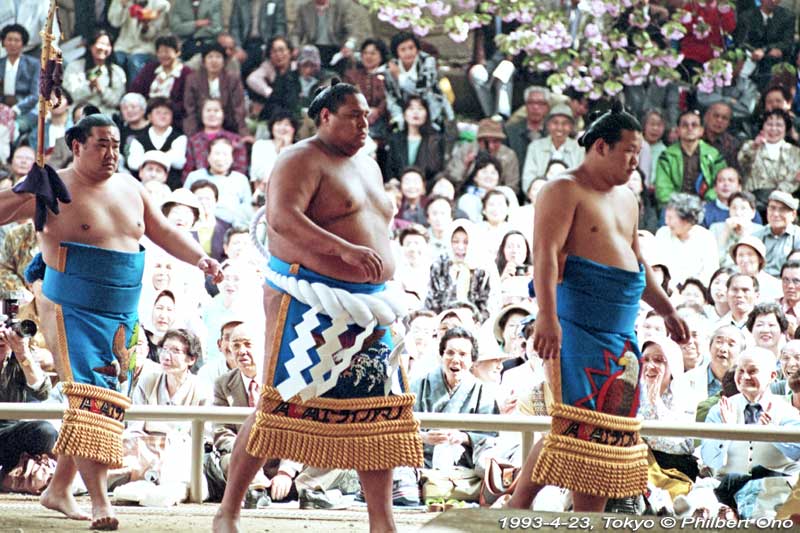
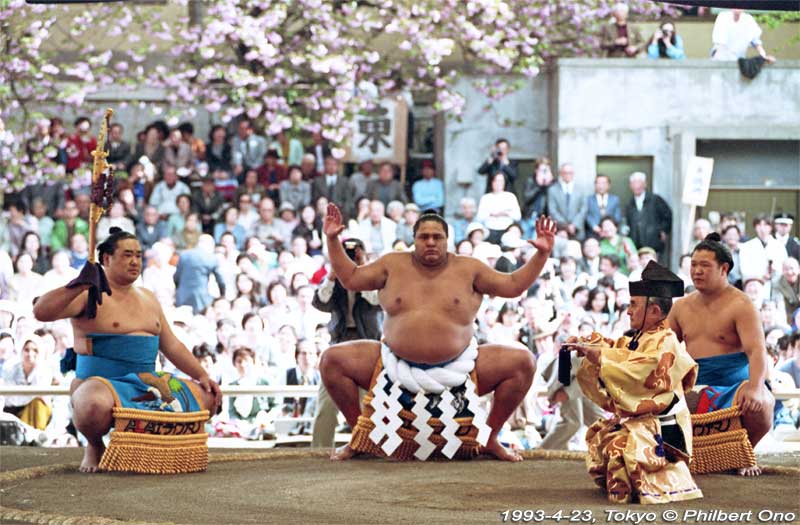
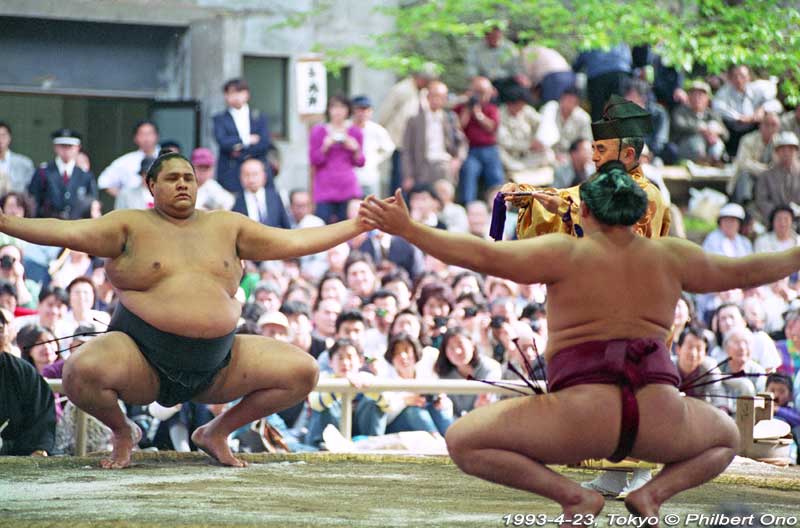
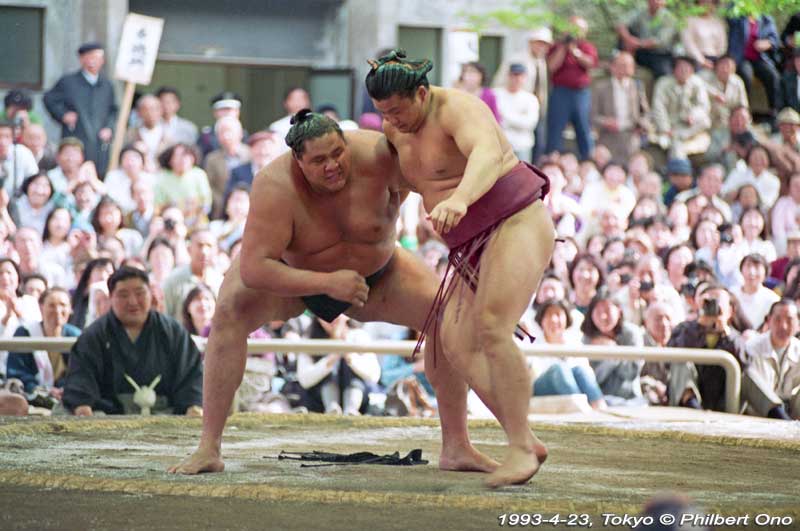
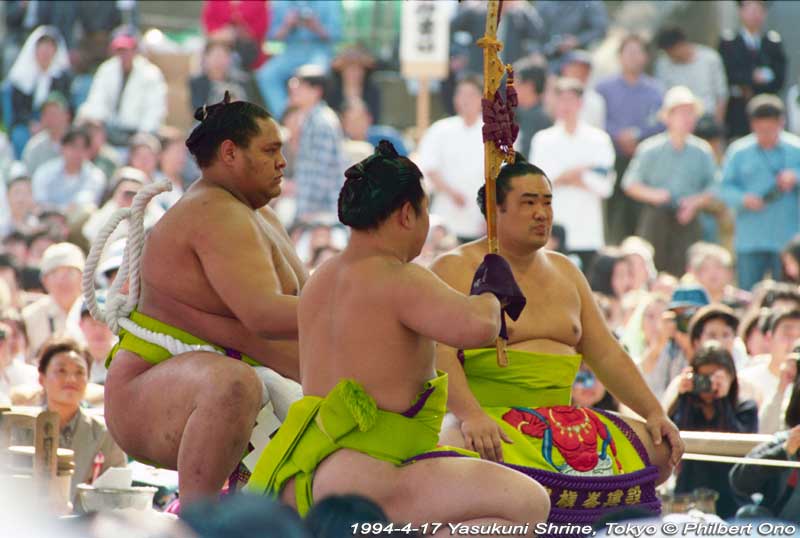
Sumo has been held at Yasukuni Shrine annually since 1869 to console the spirits at the shrine. It’s part of the shrine’s religious ceremonies and festival in spring. It’s rare to see an outdoor sumo arena in Japan. Yasukuni Shrine’s outdoor sumo arena has a capacity of 6,000. In Nov. 1918 when the old Kokugikan sumo arena was destroyed by fire, sumo tournaments were held here for two years.
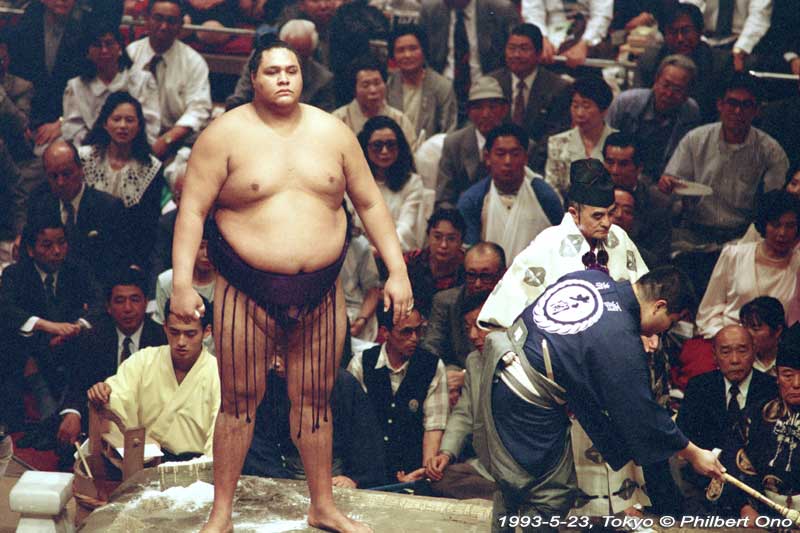
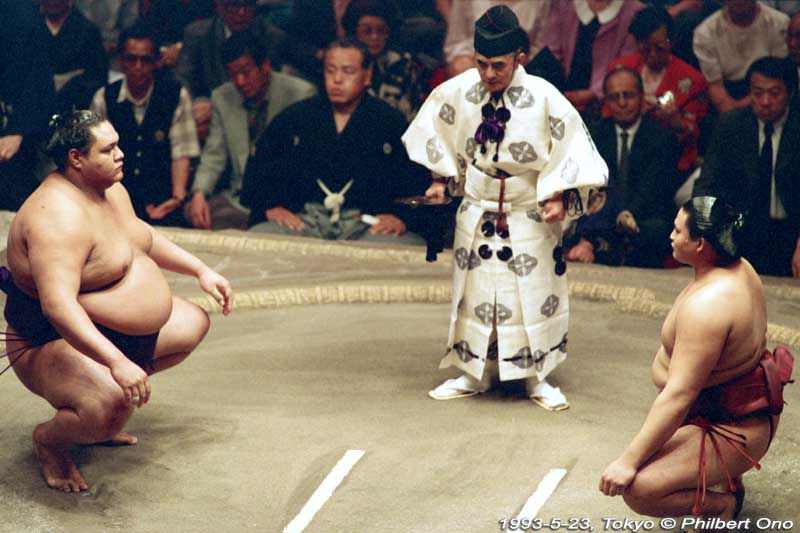

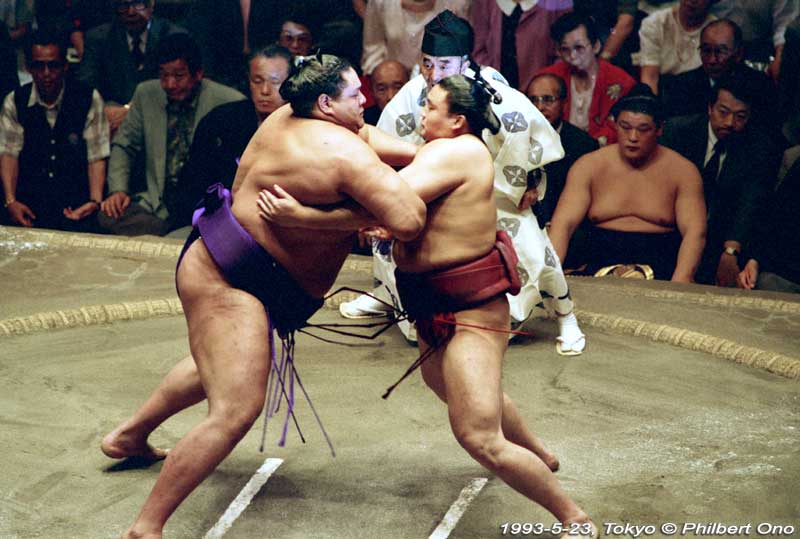
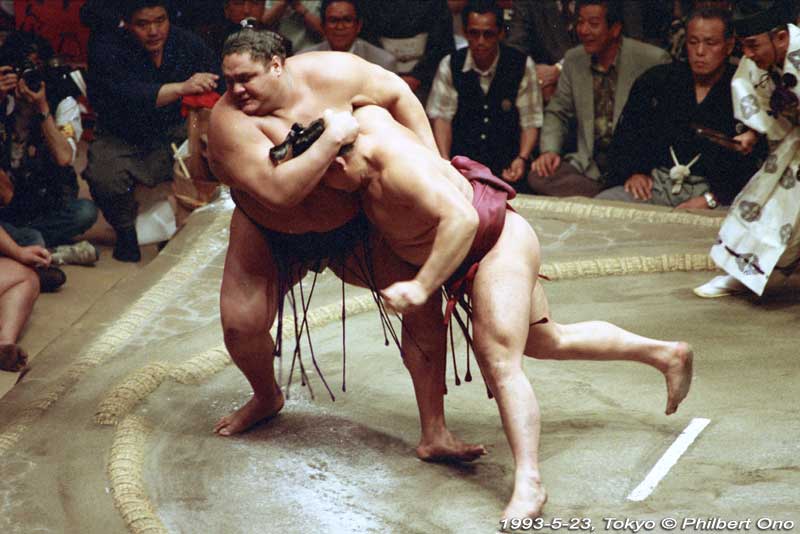
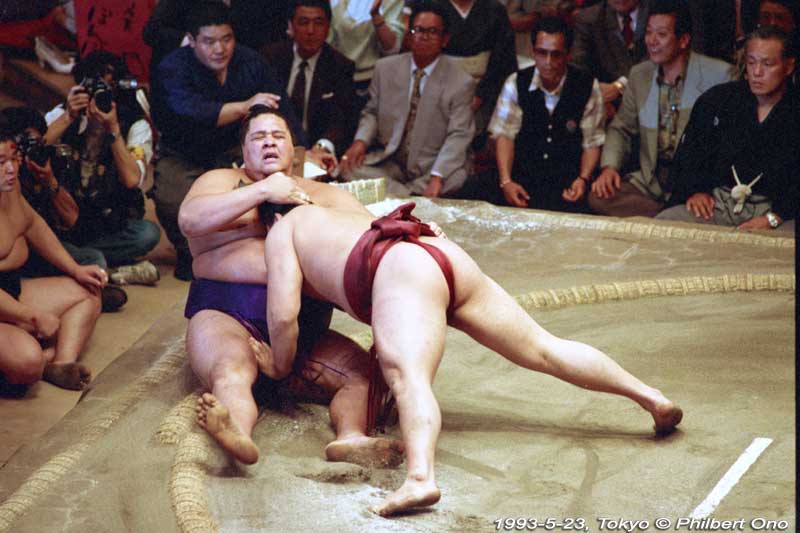
Prior to the March 1993 tournament in Osaka, a few interesting yokozuna-related tidbits were reported. On March 2, Akebono became the new Rikishi-kai chairman of the wrestlers’ association, replacing Konishiki as the representative of all Japan Sumo Association rikishi. He also got a chauffered Mercedes-Benz limousine to take him to the tournament. The license plate number was “15 00,” a pun for 15 wins and 0 losses in a regular tournament.
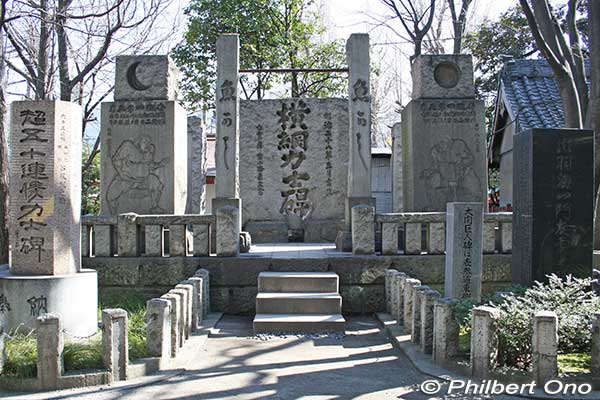

On March 12, 1993, Akebono’s name was engraved in stone at the Yokozuna Rikishi Monument within the grounds of Tomioka Hachimangu Shrine in Tokyo’s Koto Ward. This monument is engraved with the names of all the yokozuna in sumo history.
It took three hours to engrave Heisei Go-nen Ichi-gatsu 64-dai Hawai Akebono Taro (平成五年一月 六十四代 ハワイ 曙 太郎) in Japanese. This monument was built in 1895 by Jinmaku Kyugoro, the 12th yokozuna. During the Edo Period, the shrine hosted annual sumo exhibition performances before they moved to Ryogoku.
On the eve of the March 1993 tournament, the big question was, “Will Akebono make it three championships in a row?” The fact is, in the past 20 years, only one yokozuna (Takanosato in September 1983) won his debut tournament as yokozuna. Everyone else failed–Wajima, Kitanoumi, Wakanohana II, Mienoumi, Chiyonofuji, Futahaguro, Hokutoumi, Onokuni, and Asahifuji.
Kitanoumi, one of the greatest yokozuna of all time, debuted as yokozuna with a dismal 11-4 record in September 1974, and Chiyonofuji had to withdraw from his yokozuna debut tourney after 1 win and 2 losses in September 1981. It goes to show how the enormous pressure can affect new yokozunas.
Akebono, also could not break the new-yokozuna jinx. With a 10-5 record, he didn’t even come close. Wakahanada (now Wakanohana III) snatched the March championship instead. After being in the shadow of his younger brother for so long, he deserved it.
At least we could see a yokozuna and the sorely-missed yokozuna dohyo-iri.
During the March 1993 tournament, Akebono used two sets of kesho mawashi (ceremonial aprons) for his dohyo-iri ring-entering ceremony. He was flanked by dew sweeper Kenko (剣晃) and sword bearer Kiraiho (鬼雷砲), both from Takadagawa Stable.
During the first half of the tourney, Kenko wore a kesho mawashi with a large red sun rising at dawn resembling the Japanese flag, and Kiraiho’s had the familiar red, white, and blue stars and stripes. Akebono’s apron had “Akebono” in kanji and shaded to look like a sunrise. It also had a red hibiscus (Hawaii’s state flower). Symbolizing a bridge between both countries, it was a marvelous set of kesho mawashi.
During the latter half of the tournament, Kenko, Akebono, and Kiraiho wore another set of kesho mawashi each embroidered with a gold kanji character on a purple background. Kenko’s kesho mawashi showed a large kanji character for “Ha” (champion 覇), Akebono’s had a kanji for “Wa” (harmony 和), and the kanji on Kiraiho’s was “I” (with). When they lined up during the dohyo-iri, the aprons read “Hawai” (Hawaii).
He’ll be able to act and speak Hawaiian again during a triumphant homecoming exhibition sumo tournament at the Neal Blaisdell Center Arena in Honolulu on June 9-10, 1993. Hawaii sumo fans will see at least three of their own on the sumo ring. Tickets are being sold for $25 to $150.
The turn of events for the Hawaiian “tag team” during the last three decades has been progressively spectacular. What an appropriate twist of fate it was for Azumazeki oyakata, who started it all, to be the one to produce the first foreign yokozuna.
Musashimaru and other foreign rikishi have a hard act to follow. Foreigners have come a long way in sumo, and the Japanese have come a long way in accepting them. Azumazeki’s legacy and the Hawaiian sumo saga continue on with Akebono in the leading role.
Now the big question is, “Will he perform as a yokozuna should?” Upholding the dignity of the rank is even more difficult than attaining the rank itself, as many recent yokozunas have found. Yokozuna Akebono has the motivation, spirit, time, and power to become a dai-yokozuna (great yokozuna). We can look forward to his strong performances as we watch the dawning of a new sumo era.
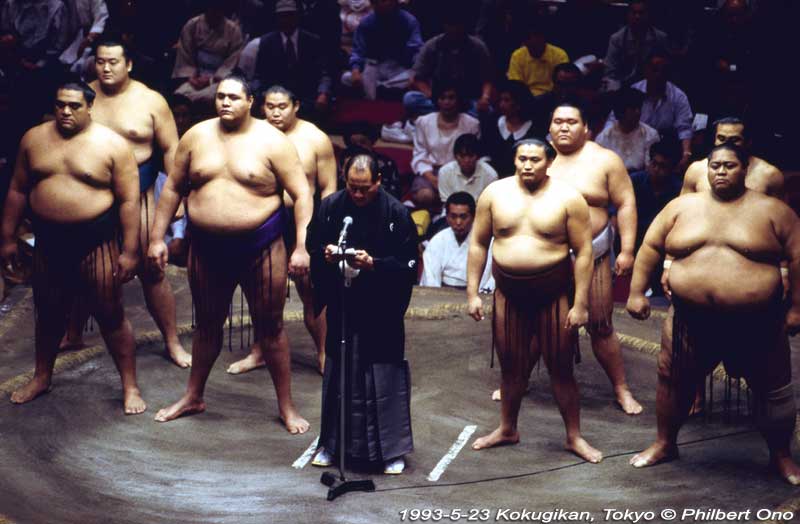



About Yokozuna Akebono (As of Sept. 2001)
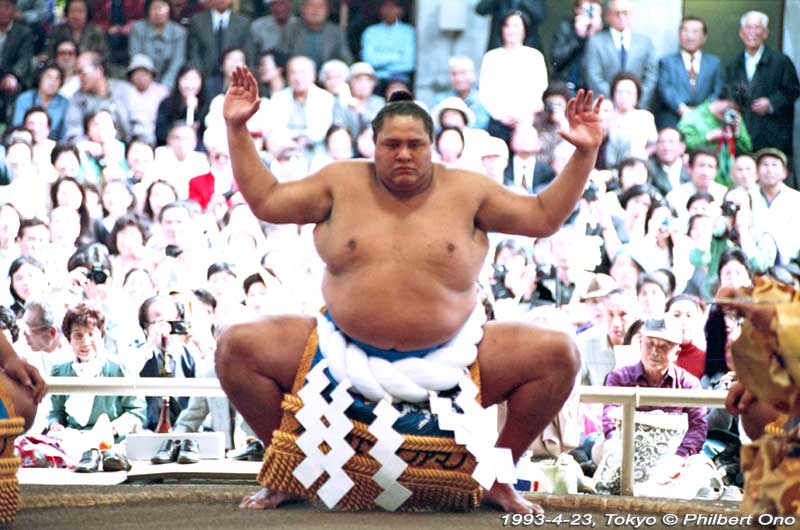
With a total of 11 tournament championships, Akebono certainly upheld the duty and dignity of a yokozuna. This total is the 7th best in the modern era, after Taiho’s 32, Chiyonofuji’s 31, Kitanoumi’s 24, Takanohana’s 21, Wajima’s 14, and Futabayama’s 12 career championships (as of Sept. 2001). Standing 203 cm (6’8″) tall and weighing 233 kg (514 lbs), he was one of the most awesome-looking grand champions ever.
Akebono, whose real name was Chad Rowan, was only 18 years old when he was scouted in Hawaii by his stablemaster Azumazeki Oyakata, the former Takamiyama or Jesse Kuhaulua who was the first foreign wrestler to reach sumo’s top division. In 1988, Akebono left Hawaii for the first time and arrived in a country he hardly knew anything about. His debut in his first sumo tournament was in March 1988. A quick 30 tournaments later in Jan. 1993, he became sumo’s first foreigner yokozuna. And not only that, he was sumo’s sole yokozuna for almost two years until Takanohana finally joined him in November 1994.
Real name: Chad George Haʻaheo Rowan
Birthdate: May 8, 1969
Birthplace: Waimanalo, Oahu, Hawaii
Education: Kaiser High School graduate, Hawaii Pacific Univ. one semester
Height: 204 cm (6’8″)
Weight: 232 kg (512 lbs.)
Immediate family: Father Randy (Irish-Hawaiian and former tour bus driver, died in 1993), mother Janice (Cuban-Hawaiian and former high school office worker, died 2006), 2 younger brothers, 1 younger sister
Stable: Azumazeki (Sumida-ku, Tokyo)
Monthly salary: ¥1,874,000 (as yokozuna in 1993)
Pre-yokozuna Record
Prizes: Shukun-sho Outstanding Performance Prize (4), Kanto-sho Fighting Spirit Prize (2), Kinboshi yokozuna upsets (4)
Tourneys in each division (Total 30): Mae-zumo (1), Jonokuchi (1), Jonidan (3), Sandan-me (2), Makushita (5), Juryo (3), Makunouchi (15)
Tourneys at each Makunouchi rank: Maegashira (5), Komusubi (3), Sekiwake (4), Ozeki (4)
Wins-losses-absences (Total 222-110-15): Jonokuchi (6-1), Jonidan (16-5), Sandanme (11-3), Makushita (25-10), Juryo (30-15), Maegashira (42-33), Komusubi (28-17), Sekiwake (28-17), Ozeki (36-9-15)
Sumo Records Held
– Most consecutive winning (kachikoshi) tournaments from Jonokuchi (18)
– Fastest rise to ozeki (26 tournaments)
– Fastest rise to yokozuna (30 tournaments)
– First foreign yokozuna
– Biggest yokozuna
Career Statistics
Total wins: 654, Total losses: 232, Total absences: 181
Makunouchi tournament championships: 11
Kinboshi (defeated Yokozuna while a low-ranking wrestler): 4 times
Outstanding Performance Award: 4 times
Fighting Spirit Award: 2 times
Number of kinboshi given (losses to low-ranking wrestlers while yokozuna): 35
Makunouchi win-loss record with Takanohana: 21-21
Makunouchi win-loss record with Wakanohana: 18-17
Makunouchi win-loss record with Konishiki: 9-8
Makunouchi win-loss record with Musashimaru: 22-16
Career Chronology
Mar. 1988: Standing 200 cm and weighing 334 pounds, Chad enters sumo with the ring name of Taikai (Big Ocean 大海) and wins 3 of 4 mae-zumo bouts.
May 1988: Enters Jonokuchi Division with ring name Akebono (曙).
July 1988: Enters Jonidan Division and weighs 337 pounds.
Jan. 1989: Enters Sandan-me Division and weighs 340 pounds at a height of 202 cm.
May 1989: Enters Makushita Division and weighs 369 pounds.
Mar. 1990: Enters Juryo Division, making him a sekitori. Weighs 386 pounds at a height of 203 cm.
Sep. 1990: Enters Makunouchi Division as Higashi Maegashira 14. Weighs 411 pounds at a height of 204 cm.
Mar. 1991: Debuts as komusubi and weighs 424 pounds.
May 1991: Debuts as sekiwake.
May 1992: Wins first tournament championship (13-2) and is promoted to ozeki. Weighs 440 pounds.
July 1992: Absent from a tournament for the first time due to a toe injury.
Nov. 1992: Wins second tournament championship (14-1).
Jan. 1993: Wins third tournament championship (13-2) and is promoted as the 64th yokozuna. (Wins 8 more tournaments before retiring.)
Mar. 1993: Debuts as yokozuna but fails to win the tournament.
June 1993: Sumo exhibition tour held in Hawaii with Yokozuna Akebono, Musashimaru, and Konishiki.
July 1993: Wins fourth tournament championship.
Sept. 1993: Wins fifth tournament championship.
Nov. 1993: Wins sixth tournament championship. On the 13th day, Akebono defeats Konishiki resulting in Konishiki’s demotion from Ozeki.
Mar. 1994: Wins seventh tournament championship.
Mar. 1995: Wins eighth tournament championship.
Apr. 1996: Becomes a Japanese citizen.
May 1997: Wins ninth tournament championship.
Feb. 1998: Performs dohyo-iri ring-entering ceremony at the Nagano Winter Olympics.
Oct. 1998: Marries Christine Reiko (27).
Nov. 1998-Mar. 1999: Skipped three tournaments in a row due to injury.
July 2000: Wins tenth tournament championship.
Nov. 2000: Wins eleventh and his final tournament championship.
Jan. 2001: Absent from the tournament and announces his retirement.
Sept. 29, 2001: Holds retirement ceremony at Kokugikan sumo arena in Ryogoku, Tokyo.
Next page here (Retirement Ceremony)…
Akebono Tribute Contents
- Azumazeki Stable
- Ozeki Promotion
- Yokozuna Promotion (Current page)
- Retirement Ceremony